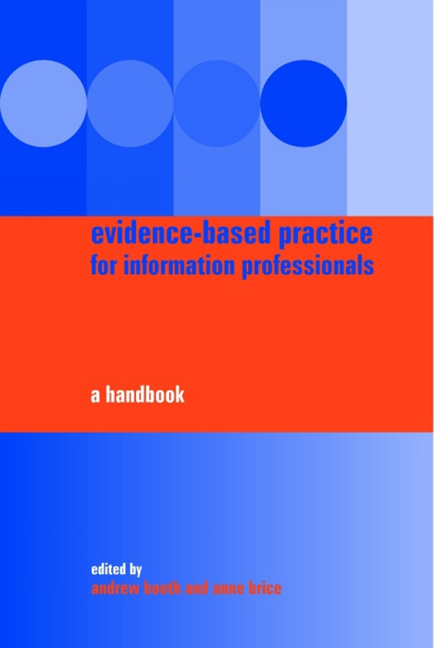Book contents
- Frontmatter
- Contents
- Foreword
- Editors and contributors
- Part 1 The context for evidence-based information practice
- Part 2 Skills and resources for evidence-based information practice
- Part 3 Using the evidence base in practice
- 13 Six domains of evidence-based information practice
- 14 Examining the evidence base for reference services and enquiry work
- Special Topic (A) Provision of a current awareness service for research staff (Guideline)
- 15 The contribution of evidence-based practice to educational activities
- Special Topic (B) How can I train my users? (Evidence Digest)
- 16 An evidence-based approach to collection management
- Special Topic (C) Electronic or paper: how do I manage my journals collection? (Evidence Digest)
- 17 Towards evidence-based management
- Special Topic (D) How do I measure the impact of my service? (Guideline)
- Special Topic (E) Should I charge and, if so, what should I charge for? (Evidence Briefing)
- 18 Evidence-based perspectives on information access and retrieval
- Special Topic (F) What are the characteristics of a good searcher? (Critically Appraised Topic)
- Special Topic (G) Which database, which interface? (Guideline) 251
- 19 Introducing an evidence-based approach to marketing and promotional activities
- Special Topic (H) Determining the information needs of practising nurses postregistration in the UK from 1990 to 2003 (Evidence Digest)
- 20 A future for evidence-based information practice?
- Index
Special Topic (A) Provision of a current awareness service for research staff (Guideline)
from Part 3 - Using the evidence base in practice
Published online by Cambridge University Press: 08 June 2018
- Frontmatter
- Contents
- Foreword
- Editors and contributors
- Part 1 The context for evidence-based information practice
- Part 2 Skills and resources for evidence-based information practice
- Part 3 Using the evidence base in practice
- 13 Six domains of evidence-based information practice
- 14 Examining the evidence base for reference services and enquiry work
- Special Topic (A) Provision of a current awareness service for research staff (Guideline)
- 15 The contribution of evidence-based practice to educational activities
- Special Topic (B) How can I train my users? (Evidence Digest)
- 16 An evidence-based approach to collection management
- Special Topic (C) Electronic or paper: how do I manage my journals collection? (Evidence Digest)
- 17 Towards evidence-based management
- Special Topic (D) How do I measure the impact of my service? (Guideline)
- Special Topic (E) Should I charge and, if so, what should I charge for? (Evidence Briefing)
- 18 Evidence-based perspectives on information access and retrieval
- Special Topic (F) What are the characteristics of a good searcher? (Critically Appraised Topic)
- Special Topic (G) Which database, which interface? (Guideline) 251
- 19 Introducing an evidence-based approach to marketing and promotional activities
- Special Topic (H) Determining the information needs of practising nurses postregistration in the UK from 1990 to 2003 (Evidence Digest)
- 20 A future for evidence-based information practice?
- Index
Summary
Scenario
As a recently appointed librarian at an academic institution you are asked to investigate the potential for a current awareness service (CAS) for research staff. Conscious of the need to provide an effective service – balancing cost with the needs of the researchers – you look at evidence to answer the question: ‘In a library serving the research community (Population) what are the optimal criteria for implementing a current awareness service (Intervention) from the perspective of the users and management (Outcomes)?’
This guideline is aimed at academic, special and health librarians.
Introduction
All researchers need to be aware of the latest peer-reviewed research. For health professionals, ‘among the many challenges physicians face, keeping our personal fund of medical knowledge up-to-date is one of the most difficult’. General physicians wishing to keep up-to-date need to read 19 articles a day, 365 days a year.
To manage this problem – and ensure researchers are alerted to new research – librarians offer current awareness services. This guideline examines evidence for providing an effective service.
Trends in current awareness services
Current awareness services appeared in three distinct phases:
Phase 1: analogue services
The need for CAS to keep researchers abreast of developments in their field was recognized as early as 1978. At this time, CAS were typically limited to photocopying, distributing tables of contents and producing accession lists, bulletins, displays and newspaper clippings.
Phase 2: databases and diskette services
By the 1990s, CAS were more sophisticated (but more expensive), with the development of electronic commercial services, such as Current Contents on Diskette and the British Library's CASIAS product. Online database vendors (OVID, Dialog, etc.) introduced SDI services that allowed librarians to define (and store) various search profiles. These could be run when the database was updated and new ‘hits’ mailed to the researcher. Literature from this period typically compares one alerting service with another. Bandemer and Tannery compare four different alerting services, whilst Davies et al.6 attempt a more comprehensive survey of over 25 different services.
- Type
- Chapter
- Information
- Evidence-based Practice for Information ProfessionalsA Handbook, pp. 159 - 163Publisher: FacetPrint publication year: 2004

